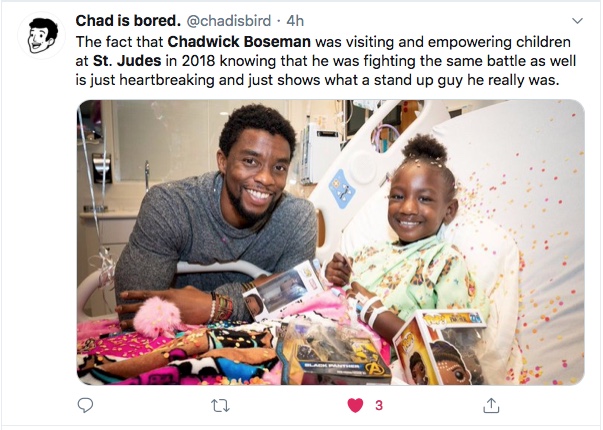
The death of Chadwick Boseman at just 43 from cancer hurts, coming as it does in a year when there’s been so much hurt already.
Just over two years ago, he was the star of the biggest superhero movie ever at the time, the first nominated for Best Picture. But he was eye-catching and charismatic in everything he appeared in during his too-short starring film career, which spanned just seven years. To most of the world’s shock and dismay, we learned that he was fighting colon cancer for much of the time he was starring in some of the biggest movies on the planet. Unimaginable.

He’s going to always be remembered for Black Panther, but he starred in several wonderful films, carving out a bit of a niche career as a chameleon portraying famous inspirational Black figures. Legendary baseball star Jackie Robinson. Soul star James Brown. The first Black U.S. Supreme Court Justice. He was very different, dazzling in each role and was much more than just T’Challa, the Black Panther. He leaves us these stories.
I always loved the Black Panther as a kid. He was mysterious and cool, and back in the 1980s, he didn’t actually appear all that often in comics. And Chadwick Boseman brought him to life wonderfully on screen, capturing the Shakespearean tumult of a Prince-turned-King wrestling with his own power. I would’ve loved to see what he did in future films.
Boseman’s pivotal place in Black film history is not my story to tell. But his starring as the Black Panther – telling millions of Black kids and adults that yes, a superhero could look like anybody – changed the parameters. He made the world bigger, and broader.

Some of us mourn actors and musicians because we see the storytellers they are, and when one of them dies suddenly or too young all you can see are the stories yet untold. Chadwick Boseman should’ve had a career stretching for decades, and it’s unfair. The last sudden film star death that hit me like this was Philip Seymour Hoffman, and I felt much the same thing – I wanted to see more. I felt cheated.
Two scenes from Boseman’s turn as the Black Panther keep ringing in my head, neither one of them your typical superhero punch-ups. One is the quiet moment at the very end of Black Panther between T’Challa and his vanquished foe Killmonger, which achieves a kind of graceful sadness. The other came at the very end of Captain America: Civil War, where T’Challa confronts Baron Zemo, the villain who assassinated his father.
Both scenes are notable for the calm centeredness of Boseman. At the end of Civil War, T’Challa decides not to kill the man he’s been hunting the entire film, and stops him from killing himself.
He tells Zemo, “The living are not done with you yet.” Yes, it’s a line by a superhero to a murderous villain, yet somehow it echoes to me so much as I think about Chadwick Boseman today.
He is free from pain now, but the living were not done with you yet.
There were so many stories left to tell.
















